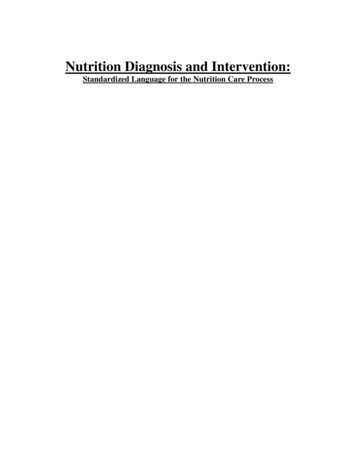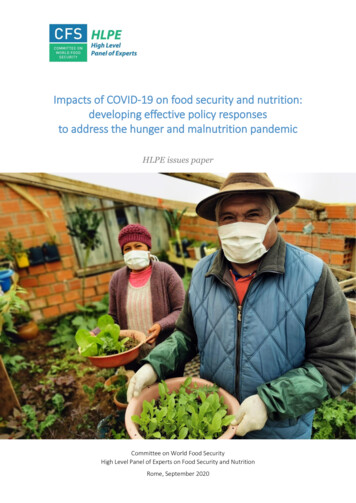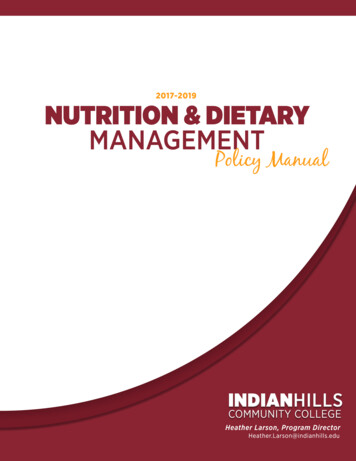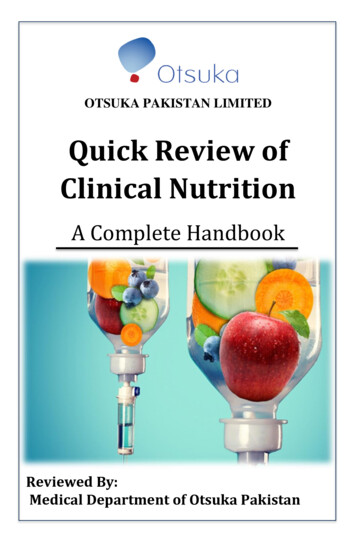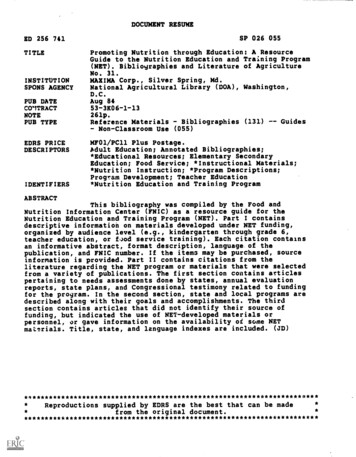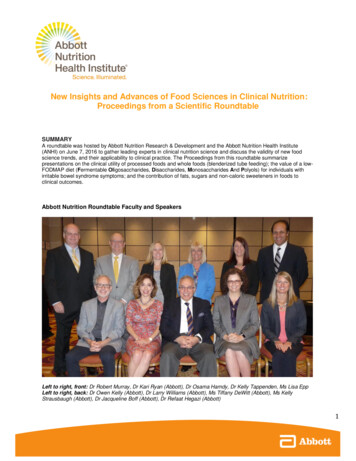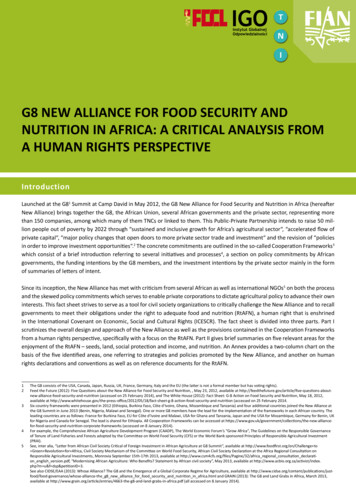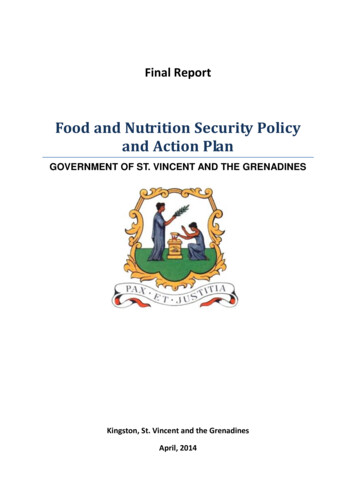
Transcription
Final ReportFood and Nutrition Security Policyand Action PlanGOVERNMENT OF ST. VINCENT AND THE GRENADINESKingston, St. Vincent and the GrenadinesApril, 2014
FOREWORDWhilst the Caribbean is making progress towards the World Food Target and the MillenniumDevelopment Goal #1 of halving the number of hungry people in the world, there still remainedalmost a million hungry people in the region. This accentuates the need for appropriate policiesand programmes that will help to address critical and immediate Food and Nutrition Securityissues that will lay the foundation for addressing long-term Food and Nutrition Security concerns.Hence, Food and Nutrition Security in the Caribbean is an important challenge to which regionalgovernments must continue to respond.Over the two decade or more the Government of St. Vincent and the Grenadines has embraced anumber of the regional and global initiatives on Food and Nutrition Security. St. Vincent and theGrenadines endorsed the FAO World Declaration on Nutrition (1992) with stated that: "Hungerand malnutrition are unacceptable in a world that has both the knowledge and the resources toend this human catastrophe. We recognize that globally there is enough food for all and.pledge to act in solidarity to ensure that freedom from hunger becomes a reality."The commitment of the Government of St. Vincent and the Grenadines to the declarations of theICN was seen in it endeavours to formulate and implement a National Plans of Action forNutrition (NPAN). Over the period 2001 to 2006, an Inter-Sectoral Council known as the NationalFood and Nutrition Security Council (FNSC) develop a NPAN for St. Vincent and the Grenadines,which was to be implemented over the period 2008-2012.In 2013 the Permanent Secretaries of the Ministry of Agriculture, Forestry, Fisheries, and RuralTransformation, and the Ministry of Health, Wellness and the Environment agreed to reactivatethe National Food and Nutrition Security Council with the aim of revising and updating the Foodand Nutrition Security Plan of Action for St. Vincent and the Grenadines (2008-2012) in keepingwith the conceptual frameworks of the Caribbean Regional Food and Nutrition Security Policyand Action Plan 2010.The initiative comes at a time when St. Vincent and the Grenadines is being given special globalrecognition as being one of an elite group of 18 countries to have met two internationallyrecognised targets in the fight against hunger: the Millennium Development Goal (MDG),number one, of halving the proportion of hungry people between 1990 – 1992 and 2010 – 2012;and the World Food Summit (WFS) goal set in 1996, of reducing by half the absolute number ofundernourished people between 1990 – 1992 and 2010 – 2012.i Page
TABLE OF CONTENTSFOREWARD . . - i TABLE OF CONTENTS . . - ii EXECUTIVE SUMMARY . . - viiACRONYMS AND ABBREVIATIONS . - ixINTRODUCTIONBackground and Context . . - 1Analytical Framework and Methodology . .- 5PART ONE:1.SITUATIONAL ANALYSIS . . -8-OVERVIEW OF THE DEMOGRAPHIC AND ECONOMIC SITUATION . -91.1Physical Characteristics . -9-1.2Demographic Characteristics . -10-1.3Macro-economic Performance . . -12-1.4Sector Performance . -161.4.1 Primary . -161.4.2 Manufacturing . -231.4.3 Tertiary . -24-2.NATIONAL FOOD AND NUTRITION SECURITY SITUATION2.1Food Availability . -272.1.1 Factors Impacting on National Food Availability . . -31-2.2Access to Food . -33ii Page
2.2.1 Poverty Situation in St. Vincent and the Grenadines -342.3Utilisation of Food . -382.3.1 Factors Affecting Food Utilisation . -38-2.4Food and Nutrition Stability . -41-2.5Profiling of Food Insecure and Vulnerable Groups in St. Vincent and theGrenadines . -43-3. REVIEW OF EXISTING POLICIES AND PROGRAMMES AFFECTING FOOD ANDNUTRITION SECURITY .-463.1Macro-Economic Policies and Strategies . -46-3.2Agricultural Policies and Programmes . -47-3.3Trade Policies . -50-3.4Poverty Alleviation and Socio-Economic Development Policiesand Programmes -55-3.5.Health Policies and Programmes . . -57-3.6Educational Policies and Programmes . . -60-3.7Infrastructure and Housing Development Policies and Programmes . -61-3.8Emergency and Disaster Management Policies and Programmes . . -62-PART TWO:FOOD AND NUTRITION SECURITY POLICY FRAMEWORK4. STRATEGIC APPROACH TO ACHIEVING FOOD AND NUTRITION SECURITY -644.1Policy Goal- Food Availability . -67-4.2Policy Goal - Accessibility -71-4.3Policy Goal - Food Utilization . -75-4.4Policy Goal - Food Stability . .-85-PART THREE: ACTION PLAN AND IMPLEMENTATION FRAMEWORK5.ACTION PLAN AND IMPLEMENTATION FRAMEWORK . -90-iii Page
5.1Action Plan. . -90Action Plan- Food Availability . . . -91Action Plan- Food Accessibility . . -100Action Plan- Food Utilization . . . -104Action Plan- Food Stability -119-5.2Implementation Framework . -123-REFERENCESANNEXESAnnex 1a:Production Estimates Permanent Crops)Annex 1b:Production Estimates (Temporary Crops)Annex 2:Key Elements of the Regional Food and Nutrition Security Policy and Action PlanLIST OF FIGURESFigure 1: Map of Trinidad and Tobago . -9Figure 2: Average Value of Food Production in St. Vincent and the Grenadines . -27Figure 3: Value of Food Imports over Total Merchandise Exports . -29Figure 4: Average Supply of Protein of Animal Origin gr/caput/day . -29Figure 5: Share of Dietary Energy Supply Derives from Cereals, Roots and Tubers -30Figure 6: Average Dietary Energy Supply Adequacy . -31Figure 7: Prevalence of undernourishment . -35-iv Page
LIST OF TABLESTable 1: Estimated Population in Each Census Division . -11Table 2: Selected Economic Indicators (2006-2011) .-13Table 3: Percentage Contribution of Gross Value added by Economic Activity in constant(2006) Prices: 2006-2011 -14Table 4: Rate of Growth of Gross Value added by Economic Activity in constant (2006)Prices: 2006-2011 .-15Table 5: Composition of Agricultural GDP . -16Table 6: Banana Exports to the UK versus Regional Exports (2005-2012) .-18Table 7: Estimated Fish Landed and Marketed 2007-2011( EC) -21Table 8: Exports of Selected Commodities (2007-2011) . . -22Table 9: Agricultural export Earnings by Destination .-23Table 10: Imports of Selected Food Categories (2009-2012) -28-v Page
EXECUTIVE SUMMARYDemographic and Socio-economic facts about St. Vincent and the Grenadines1St. Vincent and the Grenadines is an archipelagic State in the Eastern Caribbean. Overall theState covers a total land area of approximately (89% mainland and 11% cays) and a maritimearea of 27,534 square kilometres.The 2005 census estimated the population at 100,747 down from the 2001 census population of106,253, with 92% of the population residing on mainland St. Vincent. The country has aneconomically-active population of 50,000 persons.The decline in the primary productive sector and the growth of the Service industries has had aprofound impact on the Food and Nutrition Security situation of the country. This is seen in thedecline in the production and consumption of locally produced foods, the increase in the foodimport bill, increase in the number of restaurants and fast food outlets, resulting in theproliferation of poor food consumption practices and the corresponding spread of NonCommunicable Chronic DiseasesSt. Vincent and the Grenadines has available agricultural land for cultivation of about 20,000acres out of a total land acreage of over 100,000 acres. The diminution or virtual cessation ofmarket preferences internationally for St. Vincent and the Grenadines‘agricultural commodities,including bananas, has shackled the agricultural sector because of its lack of internationalcompetitiveness.Analytical Framework and MethodologyThe National Food and Nutrition Security Policy for St. Vincent and the Grenadines, will provide aframework for coordinating and mainstreaming all activities of government and civil society,related to the availability, access, quality and stability of food within the country.The Development of a National Food and Nutrition Security Policy was based on a process thatwas research driven, participatory and consultative and which sought to garner support from allrelevant areas of society.One of the initial steps in the process was the conduct of an Assessment of the existing Food andNutrition Security situation. This Situational Analysis combined several qualitative andquantitative research methods and processes.1Reference: Summarised extracts from Prime Minister’s 2012 Budget Speechvi Page
Sector Studies provided in-depth reviews and analysis of selected priority sectors and provide thefoundation for making recommendations for policy interventions based on identified gaps.In particular, the Food and Nutrition Security Policy and Action Plan incorporated therecommendations of important sector studies such as the Policy Framework and Strategic Planfor Agricultural Development 2011-2018, and the Strategic Plan for Health 2007-2011.An essential step in the Policy formulation process was the convening of The NationalStakeholder Consultation. It served to further ensure that the process was participatory andinclusive. This forum afforded stakeholders the opportunity of making major contributions inassessing the situation, identification of gaps, and recommending appropriate policy objectivesand actions.The Food and Nutrition Security Strategic Policy Framework is developed to ensure coherencewith relevant National, Regional and International policy commitments of the Government of St.Vincent and the Grenadines.Proposed policies are therefore contextualized within the frame of the Draft the NationalEconomic and Social Development Plan; Framework and Strategic Plan for AgriculturalDevelopment 2011-2018; the Draft St. Vincent and the Grenadines Trade Policy Framework(2010); the Strategic Plan for Health 2007-2011; Strategic Plan for Rural Development 2008; DraftFood and Nutrition Security Plan of Action for St. Vincent and the Grenadines (2008-2012); theEight Point Growth and Stabilisation Programme of the ECCU (Eastern Caribbean CurrencyUnion), and the various developmental instruments and programmes of the OECS and CARICOM,including the Revised OECS Regional Plan of Action for Agriculture (2012-1022); the CARICOMRegional Food and Nutrition Security Policy and Action Plan; and the CARICOM- Strategic Plan ofAction for NCDs (2011-2015).National Food and Nutrition Security SituationThe Government of St. Vincent and the Grenadines is cognisant of the close interrelationshipbetween food, nutrition and health in national development. The Government recognizes thatthe nutritional status of a population is the end product of many interrelated and complexfactors reflecting the social and economic conditions of the country. A food secure nation has thecapacity for greater productivity and is more inclined to socially acceptable behaviour.Attained the status of a Food Secure Nation is therefore considered to be a major developmentalgoal of the Government of St. Vincent and the Grenadines and forms an integral part of theNational Development PlanFood AvailabilityAgricultural production data shows that in 2012 an estimated 7401 acres of the arable landswere utilised for agricultural production. Some 3025 acres were cultivated with permanent cropsvii Page
while 4379 acres were planted with temporary crops. This represented a 22 percent decline inthe total acreage of land cultivated in relation to the area cultivated in 2008. This decline couldlargely be attributed to the decline in banana production and the abandonment of farmland by anumber of farmers.A large percentage of the food available in St Vincent and the Grenadines is imported. Theincreasing trend in the importation of foods has had an impact on the variety and quality of foodsavailable to the population. Over time this has resulted in a change in food choices and dietarypractices, particularly within the context of declining domestic food production.A review of data on food imports also reveals an increase in the importation of products classified asOils and fats and Sugar and Sugar preparations.The excess availability of food high in sugar and fat content coupled with other inadequate lifestylepractices predisposes some segments of the population to obesity and the nutrition-related chronicnon-communicable diseases such as diabetes, hypertension, heart disease, stroke and some formsof cancer.Food AccessThe critical determinants of household access are purchasing power, the ability to generateincome for various productive activities and the level prices of food. The level of poverty cantherefore be consider to be a major contributor to food and nutrition insecurity and morespecifically, access to food.Available data shows that in 2000-2002, under-nourishment was about 10.6 percent of thepopulation or eleven thousand (11,000) persons. By 2005 – 2007, the proportion of undernourished persons fell to 6.7 percent, and the absolute number to seven thousand (7,000). Thenfinally by 2010 – 2012, the proportion of under-nourished persons in the population fell to 4.9percent and the absolute number of the under-nourished to five thousand (5,000). Thus,between 2000 and 2012 the number of under-nourished persons in St. Vincent and theGrenadines fell from eleven thousand (11,000) to five thousand (5,000).Poverty is generally associated with poor environmental conditions, nutrient deficiencies, excessenergy intake, unemployment, poor care-seeking tendencies and increased risky behaviours.Poverty can therefore be considered a major barrier to accessibility to adequate nutritious food.viii Page
Food UtilisationFood Utilization as a food security pillar relates to the supply of adequate nutrition throughwholesome, healthy and diverse food choices, adherence to appropriate and acceptable foodquality and safety standards, increasing diversity in diets, as well as basic principles of nutritionand proper child care.The Government of St. Vincent and the Grenadines recognizes that the nutritional status of apopulation is the end product of many interrelated and complex factors reflecting the social andeconomic conditions of a country. It also recognizes that good nutritional status is an essentialprerequisite for optimal reproduction, growth and development and protection from disease,social well-being, as well as adequate learning and economic activity.A number of factors affect the utilization of food. These include: i) food quality and safety; ii) dietaryand lifestyle practices; iii) prevalence of micronutrient deficiencies and iv) child care practices.The maintenance of the high quality and safety of foods throughout the food chain is critical forsatisfactory nutritional status. The rapid growth of the informal food service sector hasoutstripped the capacity of the Public Health Department to monitor and regulate food safetyand sanitation. This has resulted in situation where there is unacceptably lows levels of analysisof chemical and microbial contamination of foods, whether imported or produced/processedlocally, to ascertain safety for human consumption.Over the past two decade dietary/nutritional transition has been observed in most of theCaribbean Countries, including St. Vincent and the Grenadines. This is seen in a shift away fromtraditional diets made up primarily of locally produced whole root, tubers, and vegetables tomore varied energy-dense diets based on more processed foods and beverages.Chronic Non-communicable Diseases continue to be a huge burden on the health system in St.Vincent and the Grenadines. Available data shows that non-communicable diseases accountedfor more than eighty percent (80%) of the deaths.Birth weight is an indicator of low maternal nutritional status and a predictor of the nutritionalstatus of the infant. The prevalence of low birth weight in infants as a percentage of total live births,fluctuated from 6.1% in 2000 to 6.3% in 2001 and 5.1% in 2002. Trend data also show a steady risein overweight in this population particularly in children over 24 months of age, which may beattributed to inappropriate breastfeeding, and complementary feeding patterns.ix Page
Food and Nutrition StabilitySt. Vincent and the Grenadines is one of the world’s most prone disasters areas. 2 This Caribbeanisland is exposed to: hurricanes; earthquakes and earthquake-generated ocean waves; volcaniceruptions; flooding; landslides and rockslides; and droughts.Environmental stability is particularly important to St. Vincent and the Grenadines, in light of theheavy dependence of the economy on Tourism and Agricultural production. The Food andNutrition Security Policy and Plan for the country will therefore identify appropriate policies andprogrammes that would establish and strengthen the disaster reduction management capacity ofthe country.Recommended Food Security Policy Goals and Areas of InterventionFood AvailabilityThe Government of St. Vincent and the Grenadines will ensure that consistent/stable supplies ofaffordable, nutritious, high quality food commodities are available to all people in St Vincent andthe Grenadines, through the development of competitive and diverse domestic food productionsystems and sustainable level of food imports build primarily upon mutually collaborative linkswith CARICOM countries.The Government of St Vincent and the Grenadines will ensure the achievement of the definedFood Availability Policy Goal through the pursuit and attainment of the Strategic and SpecificObjectives in a number of identified Areas of Intervention: Natural Resource Development – in particular land and water; Agriculture Human Resource Development- with particular emphasis on youth; Agriculture Diversification- based on improved Research and Development; Agro processing and agribusiness development; Effective management and utilisation of Fisheries resources; Market Development- Domestic and Export; Development of appropriate institutional structures and linkages; Partnership Development- Local, Regional and International.2Issue Paper : Sustainable Land Management in St. Vincent and the Grenadines- (P. Isaacs 2013x Page
Food AccessThe Government of St. Vincent and the Grenadines will facilitate the sustainable development ofHuman and Social Capital thereby increasing greater accessibility to safe and nutritious food,especially among vulnerable groups.The Government of St Vincent and the Grenadines will ensure the achievement of the definedFood Access Policy Goal through the pursuit and attainment of the Strategic and SpecificObjectives in a number of identified Areas of Intervention: Food and Nutrition Insecurity monitoring and Vulnerability Mapping Reduction of poverty and unemployment Zero Hunger and Undernourishment Targeted and effective safety net programmes Access to basic services among some vulnerable groups Creation of employment and income generating opportunitiesFood UtilisationThe Government of St. Vincent and the Grenadines will improve the nutritional status and wellbeing of the population of St Vincent and the Grenadines through the promotion of andcommercialization and consumption of safe, affordable, nutritious quality Caribbean foodcommodities/products.The Government of St Vincent and the Grenadines will ensure the achievement of the definedFood Utilization Policy Goal through the pursuit and attainment of the following Strategic andSpecific Objectives in a number of identified Areas of Intervention: Food Quality and Safety; Care for the Socio-economically Deprived and Nutritionally Vulnerable Groups Dietary and Lifestyles Practices Prevalence of Micronutrient Deficiencies Child Care Practices Assessing, Analysing and Monitoring Food and Nutrition Situationsxi Page
Food StabilityThe Government of St. Vincent and the Grenadines will support the development andimplementation of sustainable and environmentally friendly mitigation strategies to ensure thatNational Food and Nutrition Security systems are resilience to natural and socio-economic shocksincluding climate change.The Government of St Vincent and the Grenadines will ensure the achievement of the definedFood Stability Policy Goal through the pursuit and attainment of the following Strategic andSpecific Objectives in a number of identified Areas of Intervention: FNS Early Warning Information and Management System Disaster Preparedness and Management Emergency Distribution Programmes Climate ChangeImplementation FrameworkExperiences with regards to the implementation of FNS Policies and Plans in several countrieshave shown that an effective and efficient implementation framework is one that ensures isinter-sectoral and multi-sectoral coordination. The Implementation of a Food and NutritionSecurity Action Agenda requires complementary interventions in different sectors (agriculture,health, trade and education, and planning) and at different levels (household, community,national and regional)The Institutional Framework being proposed as part of this FNS Policy and Plan would be one thatbuilds on the structure established by the National Food and Nutrition Security Council (FNCS) thatwas established in 2006.It is recommended that the National Food and Nutrition Security Council (NFNSC) be retained as theprimary Executive Body with responsibility for coordinating the implementation and monitoring ofthe National Food and Nutrition Security Policy and Plan. It is further recommended that the NFNSCbe comprised of five sub-committees, four of which are in keeping with the pillars of food andnutrition security. The fifth committee would be responsible for the coordination of information,monitoring and evaluationAn Inter-Ministerial Committee will also form part of the implementation framework and will rbe responsible for giving political direction by making policy decisions and reporting to the PrimeMinister and to Parliament regarding progress towards achieving food and nutrition securitytargets, as well as to serve as the link to relevant national and regional organizations.xii Page
ACRONYMS AND ABBREVIATIONSALBABolivian Alternative for the AmericasBNTFBasic Need Trust FundCBERACaribbean Basin Economic Recovery ActCBICaribbean Basin InitiativeCBTPACaribbean Basin Trade Partnership ActCDBCentral Development BankCFNICaribbean Food and Nutrition InstituteCOTEDCARICOM Council on Trade and Economic DevelopmentECIsEarly Childhood InstitutionsEUEuropean UnionFAOFood and Agricultural OrganisationFNSFood and Nutrition SecurityFBDGFood Based Dietary GuidelinesFNSFood and Nutrition SecurityGDPGross Domestic ProductHFLACIHunger Free Latin America and the CaribbeanICNInternational Conference on NutritionIYCNInfant and Young Child NutritionMARTFFIMinistry of Agriculture, Rural Transformation, Forestry, Fisheries and IndustryMDGMillennium Development GoalNCDsNon-Communicable DiseasesNG0Non-Governmental OrganisationNPANNational Plan of Action for NutritionNTANational Tourism AuthorityPAHOPan American Health OrganisationRFNSPRegional Food and Nutrition Security PolicySVGSt. Vincent and the Grenadinesxiii Page
TCPTechnical Cooperation ProjectTVETTechnical and Vocational Education and Training (TVET);UNUnited NationsUNFCCCUnited Nations Framework Convention on Climate ChangeWFSWorld Food SummitWHOWorld Health OrganisationYESYouth Empowerment Servicexiv Page
INTRODUCTION
BACKGROUND AND CONTEXTNumerous publications by the United Nations estimate that by 2050 the world’s population willreach 9.1 billion, 34 percent higher than today. Nearly all of this population increase will occurin developing countries. Urbanization will continue at an accelerated pace, and about 70percent of the world’s population will be urban (compared to 49 percent today). Income levelswill be many multiples of what they are now.”“In order to feed this larger, more urban and richer population, food production must increaseby 70 percent. Annual cereal production will need to rise to about 3 billion tonnes from 2.1billion today and annual meat production will need to rise by over 200 million tonnes to reach470 million tones.” 3Ensuring current and long-term Food and Nutrition Security in the Caribbean is therefore animportant challenge to which governments must respond. Whilst the Caribbean is makingprogress towards the World Food Target and the Millennium Development Goal 1 of halvingthe number/proportion of hungry people in the world, there still remained almost a millionhungry people in the region. This accentuates the need for appropriate policies andprogrammes that will address critical immediate Food and Nutrition Security issues and also laythe foundation for addressing long-term Food and Nutrition Security concerns.Over the past two decades and more, a number of global and regional initiatives haveinfluenced the national drive towards making St. Vincent and the Grenadines a food andnutrition secured nation. St. Vincent and the Grenadines endorsed the FAO World Declarationon Nutrition (1992) with stated that: "Hunger and malnutrition are unacceptable in a world thathas both the knowledge and the resources to end this human catastrophe. We recognize thatglobally there is enough food for all and. pledge to act in solidarity to ensure that freedomfrom hunger becomes a reality."Recognizing the gravity of the global Food and Nutrition situation, FAO and the World HealthOrganization (WHO) convened the first global conference devoted solely to addressing theworld's nutrition problems, the International Conference on Nutrition (ICN), at FAOHeadquarters in Rome in December 1992.During the ICN, governments pledged to make all efforts to eliminate or reduce substantially,before the next millennium, starvation and famine; widespread chronic hunger; undernutrition, especially among children, women and the aged; micronutrient deficiencies,especially iron, iodine and vitamin A deficiencies; diet-related communicable and noncommunicable diseases; impediments to optimal breast-feeding; and inadequate sanitation,poor hygiene and unsafe drinking-water.3FAO: (2009) How to Feed the World in 2050-1- Page
The World Declaration on Nutrition and Plan of Action for Nutrition also serve as a guide to thetechnical issues of nutrition policy and programme development. Nine priority themes wereelaborated in the Plan of Action for Nutrition: incorporating nutritional objectives, considerations and components into developmentpolicies and programmes; improving household food security; protecting consumers through improved food quality and safety; preventing and managing infectious diseases; promoting breast-feeding; caring for the socio-economically deprived and nutritionally vulnerable; preventing and controlling specific micronutrient deficiencies; promoting appropriate diets and healthy lifestyles; assessing, analysing and monitoring nutrition situations.The commitment of the government of St. Vincent and the Grenadines to the declarations ofthe ICN was seen in it endeavours to formulate and implement a National Plans of Action forNutrition (NPAN). Over the period 2001 to 2006, an Inter-Sectoral Council known as theNational Food and Nutrition Security Council (FNSC) develop a NPAN for St. Vincent and theGrenadines.The NPAN was intended to represent the country's particular priorities and strategies foralleviating hunger and malnutrition. It would also serve as a mechanism for mobilizing politicaland funding support for food and nutrition programmes.In keeping with its own social and economic development priorities and in accordance with theInternational Conference on Nutrition (1992); The Caribbean Health Promotion Charter (1993); theWorld Food Summit (1996); and the Caribbean Cooperation in Health Initiative - Phase III (2007);on May 2006 the Government of St. Vincent and the Grenadines ratified a Food and NutritionPolicy for St. Vincent and the Grenadines.On October 2006 the Government of St. Vincent and the Grenadines launched the first NationalFood and Nutrition Security Policy. This Policy was to be implemented by National Food andNutrition Security Council (FNSC). The Council’s overall goal was “to attain Food and NutritionSecurity for all persons in St. Vincent and the Grenadines”. This Policy framework provided themechanism for the planning, implementation and monitoring of a comprehensive set of policiesand programmes aimed at improving the food and nutrition situation of the entire population ofSt. Vincent and the Grenadines.In 2008, the government of St. Vincent and
The National Food and Nutrition Security Policy for St. Vincent and the Grenadines, will provide a framework for coordinating and mainstreaming all activities of government and civil society, related to the availability, access, quality and stability of food within the country. The Development of a National Food and Nutrition Security Policy .


